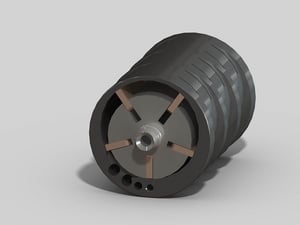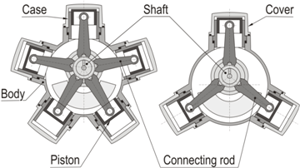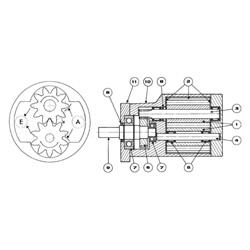Most air motors are available in three types: with vanes, pistons or gears. Each type has its own particular characteristics.
 Pneumatic vane motors
Pneumatic vane motorsAir vane motors are made up of a cylinder (called a stator) containing an eccentric rotor closed at both ends. The space created between the stator and the rotor is kidney-shaped. The rotor has grooves in which the vanes can move freely. The compressed air feeds into the motor at one end and escapes through an opening in the cylinder. To ensure the motor starts correctly, the air feeds in first under the vanes, pushing them against the interior wall of the cylinder. Once the motor is in motion, the centrifugal force takes over.
The advantage of air vane motors is their simple design. Maintenance is easy as the motors are simple to take apart and the parts that wear out (filters, vanes) cost very little to replace.
This is the most common type of pneumatic motor – compact, economical and with a simple design, it is perfectly adapted for use in numerous devices in various industry sectors such as the food, agricultural, petrochemical and even nuclear industries.
Air vane motors operate with clean, filtered air that should be correctly lubricated. Depending on the appliance or intended end use, it is possible to opt for a specifically designed motor that can be used without lubrication.
Vane motors rotate at higher speeds providing greater power relative to their weight than piston motors. However, they offer a less effective starting torque. Vane motors are lighter and less expensive than piston motors, and operate at the same power.

Piston air motors have 4 to 6 cylinders. Power is generated by the pressure held in each cylinder. They operate at lower revolution levels than vane motors. These motors have a high starting torque and good control over their speed. They are suited to working with heavy loads at low speeds. The pistons can be either axial or radial.
The basic idea of the piston air motor is to offer a motor that rotates at slow speed while providing a high torque.
 Double rotor air motors
Double rotor air motorsDouble-motor air motors consist of two gear wheels turning on their axis with minimal interplay. One gear wheel is fixed to the output shaft, while the other wheel generates the torque. Two flat flanges are driven by a blast of compressed air in the rotating direction, and another moves in the opposite direction. The escaping air is directed into the chambers formed between the flange and the chassis wall towards the exhaust valve, which produces the rotation action.
These very specific motors are just a small sample of our range of pneumatic motors.
Modec has been designing and assembling motors at its site in Valence for many years and our products are known for their excellent quality. Our vane air motors are regularly used as an alternative to traditional electric motors in a number of highly restrictive applications in nearly all sectors of industry.
Our technical team is available to work with you to study, design and manufacture pneumatic motors that meet your specific needs, for your specific projects!

+ 33 (0) 4 75 40 27 15
sales@modec.fr
ZI Sirius Quatre
80, allée René Higonnet
26760 Beaumont-lès-Valence, FRANCE
© Tous droits réservés - Modec - Création : ARKOD